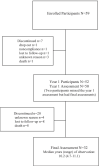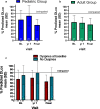Prospective study of the natural history of chronic acid sphingomyelinase deficiency in children and adults: eleven years of observation
- PMID: 33971920
- PMCID: PMC8111900
- DOI: 10.1186/s13023-021-01842-0
Prospective study of the natural history of chronic acid sphingomyelinase deficiency in children and adults: eleven years of observation
Abstract
Background: Acid sphingomyelinase deficiency (ASMD) (also known as Niemann-Pick disease types A and B) is a rare and debilitating lysosomal storage disorder. This prospective, multi-center, multinational longitudinal study aimed to characterize the clinical features of chronic forms of ASMD and disease burden over time in children and adults.
Results: Fifty-nine patients (31 males/28 females) ranging in age from 7 to 64 years with chronic ASMD types A/B and B and at least two disease symptoms participated from 5 countries. Disease characteristics were assessed at baseline, after 1 year, and at the final visit (ranging from 4.5 to 11 years). Thirty patients (51%) were < 18 years at baseline (median age 12 years), and 29 were adults (median age 32 years). Overall, 32/59 patients completed the final visit, 9 died, 9 discontinued, and 9 were lost to follow up. Common clinical characteristics that tended to worsen gradually with time were splenomegaly, hepatomegaly, interstitial lung disease, lung diffusion capacity (DLCO), and dyslipidemia. Spleen volumes ranged from 4 to 29 multiples of normal at baseline, and splenomegaly was moderate or severe in 86%, 83%, and 90% of individuals at baseline, year 1, and final visits, respectively. The proportion of all individuals with interstitial lung disease was 66% (39/59) at baseline and 78% (25/32) at the final visit, while median % predicted DLCO decreased by > 10% from baseline to the final visit. Nine patients died (15%), eight of causes related to ASMD (most commonly pneumonia); of these eight patients, five (63%) had symptom onset at or before age 2. Overall, six of the nine deaths occurred before age 50 with three occurring before age 20. Individuals with either severe splenomegaly or prior splenectomy were ten times more likely to have died during the follow-up period than those with smaller or intact spleens (odds ratio 10.29, 95% CI 1.7, 62.7). Most children had growth deficits that persisted into adulthood.
Conclusions: This study provides important information about the natural history of chronic ASMD and provides a longitudinal view of the spectrum of disease manifestations and major morbidities in children and adults and supports the selection of clinically meaningful endpoints in therapeutic trials.
Keywords: ASMD; Lysosomal storage disease; Natural history; Niemann-Pick disease type A/B; Niemann-Pick disease type B.
Conflict of interest statement
MMM has received honoraria and travel reimbursement from Sanofi Genzyme for participation in advisory boards. BB and MTV have received investigator fees from Sanofi Genzyme. MW, RG and EM have received investigator fees, honoraria, and reimbursement of travel expenses to attend scientific meetings from Sanofi Genzyme. QZ and MJP are employees of Sanofi Genzyme.
Figures






References
Publication types
MeSH terms
Substances
Grants and funding
LinkOut - more resources
Full Text Sources
Other Literature Sources
Medical

